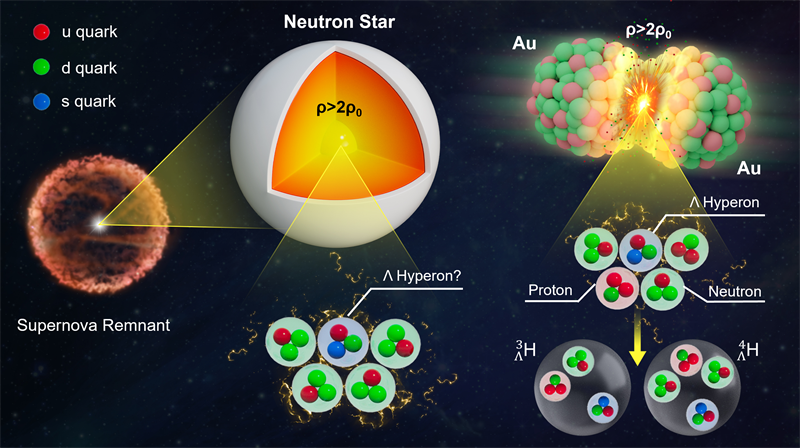
Scientists from the Institute of Modern Physics (IMP) of the Chinese Academy of Sciences (CAS) and their collaborators in the RHIC-STAR experiments have observed the collective flow of hypernuclei in heavy-ion collisions for the first time. This achievement offers a new direction for studying hyperon-nucleon (Y-N) interactions in dense nuclear matter environments. The study was published in Physical Review Letters on May 24.
Hyperons are baryons that contain strange (s) quark, while nucleons (proton and neutron) only contain up (u) and down (d) quarks. Hyperons and nucleons can form bound states, which are called "hypernuclei". Theoretical predictions suggest that hyperons exist in the interiors of neutron stars, which are compact stars in the universe. However, the appearance of hyperons will soften the equation of state of nuclear matter, which brings challenges to the theoretical construction of massive neutron stars. This is known as the "hyperon puzzle" in neutron star research.
Extracting strength of Y-N interaction in dense nuclear medium experimentally is essential to solve the "hyperon puzzle", meanwhile it has a great significance for understanding the theory of strong interaction-Quantum Chromodynamics (QCD). Collective flow of hypernuclei may be used to extract the Y-N interactions in the dense nuclear matter and to solve the "hyperon puzzle".
High-energy heavy ion collisions are a unique tool for studying the properties of dense nuclear matter in the laboratory. In heavy-ion collisions, due to the pressure gradient of dense nuclear matter, particles exhibit collective flow such as directed flow and elliptic flow. Scientists have observed collective flow of mesons, baryons and light nuclei in experiments. However, owing to the rarity of hypernuclei production, experimental data on hypernuclei collective flow was lacking.
In this work, the experiment was conducted on the Relativistic Heavy Ion Collider (RHIC) at the Brookhaven National Laboratory in the United States. Based on the 3 GeV Au-Au collision data of the Solenoidal Tracker at RHIC (STAR) experiment, scientists reconstructed about 8400 hypertriton (consisting of a Λ hyperon, a proton and a neutron) and about 5200 hyperhydrogen-4 (consisting of a Λ hyperon, a proton and two neutrons). This has been the largest statistical data sample of hypertriton and hyperhydrogen-4 observed experimentally so far.
Scientists observed that these hypernuclei have a significant directed flow for the first time. Meanwhile, they extracted the slopes of the directed flow of hypernuclei and light nuclei in the mid-rapidity region. They found that the slopes of light nuclei and hypernuclei follow a similar mass number scaling, indicating that the production of hypernuclei and light nuclei in heavy ion collisions could be explained by the "coalescence process".
This work offers a new direction for studying Y-N interaction under finite pressure, which is important for making the connection between nuclear collisions and the equation of state which governs the inner structure of compact stars.
STAR is an international experimental collaboration at RHIC, composed of more than 700 researchers at 71 institutions from 14 countries. This work was led by Prof. ZHANG Yapeng's team from IMP. Principal authors of this study include his collaborator HU Chenlu (PhD student), Dr. HE Xionghong and ZHAO Fengyi (PhD student) from IMP, and Dr. DONG Xin, Dr. JI Yuanjing and Dr. LEUNG Yue-Hang from the Lawrence Berkeley National Laboratory in US.






